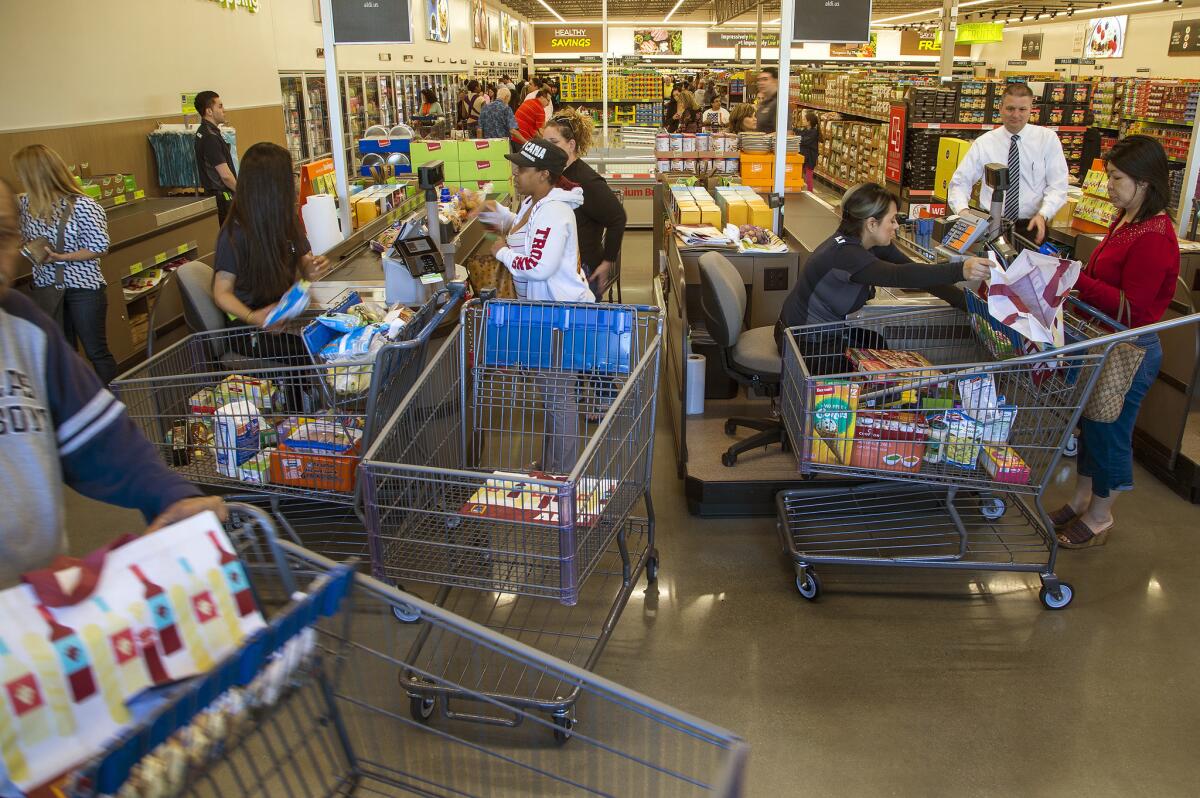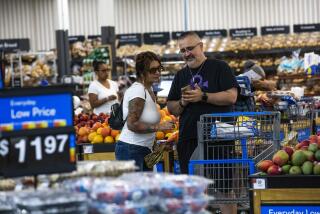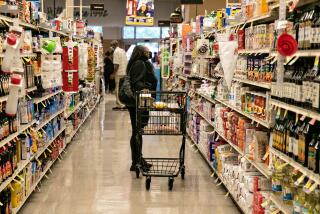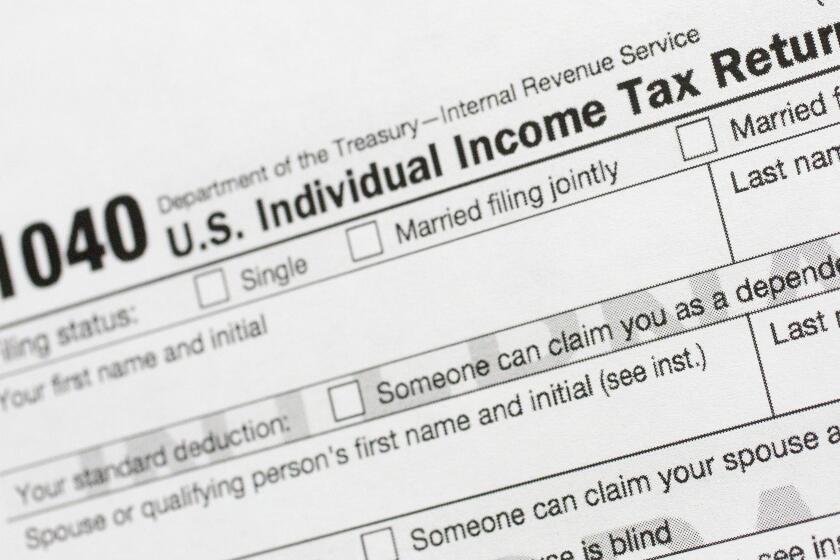Why cheaper food in 2016 was not necessarily good news

For food shoppers, 2016 was a back-to-the-future experience, with retail prices deflating for the first time since Lyndon Johnson was president.
The year is expected to end with an annual drop of between 0.5% and 1.5% in the retail price of food prepared at home, according to the U.S. Department of Agriculture’s Economic Research Service.
In plain English, that’s the mostly raw food you put in your grocery cart, as opposed to cooked and prepared food at a restaurant or fast-food counter, the price of which went up 2.4% this year.
Unless your shopping basket was heavy with guacamole during the months when labor and weather issues sent the price of Mexican avocados skyrocketing, your grocery bills probably were lower this year.
That might be reason enough for consumers to cheer, but deflation after several years of flat price growth has complicated the ledgers of growers and grocers alike.
Kroger Co., a Cincinnati-based chain that owns Ralph’s supermarkets, cut its sales and profit forecasts and lowered its capital investment plans after two difficult quarters earlier this year. It is offering buyouts to about 2,000 non-store employees, in what some say is a prelude to layoffs at the chain.
Privately held Albertsons, which has postponed an initial public offering of stock, acknowledged struggling with “deflationary trends” this year. The company, which operates Vons, Safeway and Pavilions stores among other brands, reported that sales growth dropped to 1.7% in the first two quarters of 2016, compared with nearly 5% annual sales growth in 2015, according to Securities and Exchange Commission filings.
“For grocers, of course, it’s harder for them to show top-line increases in sales,” said Brian Todd, president and chief executive of the Food Institute, a nonprofit organization that tracks economic trends from farm to plate. “They’ve gone toward trying to save money in other areas.”
The annual value of U.S. agricultural sector production is expected to fall 5.9%, to $403.7 billion in 2016, almost entirely due to declines in the value of animals and animal products, according to the U.S. Department of Agriculture.
Net farm income, meanwhile, should post an annual decline of 17.2% from 2015, after a nearly 13% decline from 2014, according to the USDA.
Analysts mostly blame a strong U.S. dollar, which dampened exports and made imported goods cheaper. U.S. agricultural exports are expected to decline by $1 billion to about $139 billion, while imports are projected to post a $7-billion gain to a record $123 billion, according to the USDA.
Depressed exports proved to be a double whammy — more U.S. products wound up in the domestic market, which was flooded at the same time with cheaper imports, said Annemarie Kuhns, an economist with the USDA’s Economic Research Service.
In addition, lower oil prices made it cheaper to cultivate, package and process food. “It’s only natural that this would manifest itself in food prices,” said John Newton, director of market intelligence for the American Farm Bureau Federation, an agriculture industry group.
The effects, however, were uneven. California’s lingering drought, which made water more expensive, pushed the price of fruit up 2% and vegetables up about 1%, according to the USDA.
“One of the reasons we’re seeing fresh fruit and vegetable prices still increasing in 2016 despite all these other factors that are putting downward pressure on prices is because California is the largest agricultural state for fresh fruits and vegetables in the U.S.,” Kuhns said.
Most of the depressed prices, however, came from the protein side of the plate. Retail prices for beef and veal are expected to end the year down about 6% to 7%, pork is expected to slide 3% to 4% and poultry will be down about 2% to 3%, according to the USDA, which will not finalize its figures until early next year.
Eggs are selling at about two-thirds of last year’s price, mostly because they are rebounding from high prices caused by an avian flu epidemic that forced poultry producers to euthanize millions of hens last year, according to the USDA.
Beset by overproduction and competition from imports, the dairy industry was so bad this year that the federal government bought back $20 million in cheese, while producers ditched excess milk inventory. Exports and domestic demand are recovering, however, and USDA predicts that dairy will nearly reverse this year’s 1.5% to 2.5% decline.
“Dairy imports have declined from very high levels in the first quarter of 2016, so we’re kind of expecting to see supply tighten domestically and also expecting to see exports to strengthen into 2017,” Kuhns said.
The beef and veal deflation hit around midyear, largely because of decisions made in 2015 as Texas and Oklahoma recovered from a five-year drought that had driven up prices, Kuhns said.
“Improved pasture conditions and lowered feed prices enticed a lot of these ranchers to increase their herd sizes, so we’re starting to see the effects on the wholesale and retail side,” Kuhns said.
Most of these trends are not expected to last beyond the first two quarters of 2017. The USDA predicts a modest annual increase of half a percentage point to 1.5% in retail food prices.
“We keep on looking to see when it’s going to turn around; our best guess is somewhere in the second quarter, perhaps we’ll start to see that deflation go away,” Todd of the Food Institute said. “They can’t continue to go down at the level that they have.”
Agriculture remains a good investment, despite small declines in average debt-to-asset ratios — currently at 13%, a couple of points higher than record lows in 2010-12.
“I’d call that period the golden age of agricultural income,” Newton of the American Farm Bureau Federation said.
Consumer and environmental activists cautioned against painting agriculture with too much doom and gloom. Agriculture’s solvency ratios remain far lower than they were in the crisis of the 1980s and 1990s, and this year, incomes will be markedly higher in farm households than in non-farm households, according to the Environmental Working Group, which has been critical of federal farm subsidies.
“The farm subsidy lobby is working overtime to use what it calls a ‘farm crisis’ to deflect well deserved criticism of the fatally flawed federal subsidy system that they’re desperate to protect,” the group wrote in a May report.
Follow me: @LATgeoffmohan
More to Read
Inside the business of entertainment
The Wide Shot brings you news, analysis and insights on everything from streaming wars to production — and what it all means for the future.
You may occasionally receive promotional content from the Los Angeles Times.











